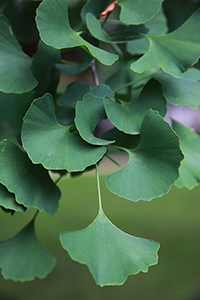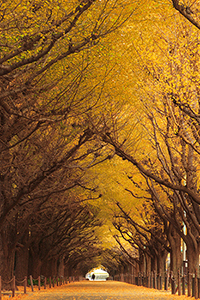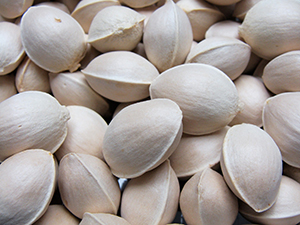Ginkgo biloba


Other common names
Chinese - Yin xing
Origin of the species name
Ginkgo was an attempt at Romanising a Chinese name; biloba is from Latin referring to the two lobes on the leaves.
Family
Ginkgoaceae
Date planted
March 2008
Lifespan
Ginkgo trees can live for over 1,000 years.

General description
This is a large deciduous tree that has separate male and female trees. Its dark green leaves are the shape of the maidenhair fern leaflets and they turn brilliant gold in autumn. Greenish catkin-like cones appear on male trees in spring, and female trees produce round fruits, 1.5-2 cm in diameter (sometimes twin fruits), on single stalks. The fruit is pale yellow-brown when ripe in autumn. Fallen fruit is foul smelling but the seeds inside are edible when roasted. Although it is more like a conifer than a deciduous broadleaf tree, it is neither. Recent research suggests a much closer relationship to the cycads than to the conifers and it is placed in a division of its own, 'Ginkgophyta'. Height 30m Spread 15m.
Natural distribution and habitat
The species is native to south east China. It occurs in small scattered populations in broad leaved forests up to 1,100m on well drained acidic soils. Trees have been planted around temples in China and Japan for over a thousand years. Fossil evidence indicates that ginkgos were once widespread around the world.
Conservation status
Although it is a very widely cultivated tree for hundreds of years, it is an endangered species in the wild with very few natural populations known. Some possibly wild populations still exist on Xitianmu Mountain, Zhejiang, in China.
Planting pattern
This forest is mostly planted in a regular diamond grid pattern. Gaps in the forest relate to the footprint of major buildings in China's Forbidden City.
Uses
The nut-like seeds are a traditional Chinese food and are particularly esteemed in Asia. They are often served at special occasions such as weddings and Chinese New Year. Numerous leaf extracts have also been widely used as traditional medicines. They have been thought to improve mental functions such as memory, intelligence, motivation, and concentration. The species is also known to be very hardy. Trees growing just 1–2 km from the 1945 atom bomb explosion in Hiroshima were among the few living things in the area to survive the blast.
Further reading
Maidenhair Tree Story by Susan Parsons,
